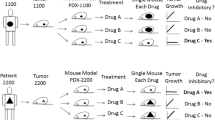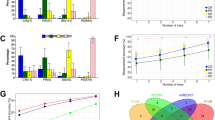Abstract
Tumor growth inhibition (TGI) models are increasingly used during preclinical drug development in oncology for the in vivo evaluation of antitumor effect. Tumor sizes are measured in xenografted mice, often only during and shortly after treatment, thus preventing correct identification of some TGI model parameters. Our aims were (i) to evaluate the importance of including measurements during tumor regrowth and (ii) to investigate the proportions of mice included in each arm. For these purposes, optimal design theory based on the Fisher information matrix implemented in PFIM4.0 was applied. Published xenograft experiments, involving different drugs, schedules, and cell lines, were used to help optimize experimental settings and parameters using the Simeoni TGI model. For each experiment, a two-arm design, i.e., control versus treatment, was optimized with or without the constraint of not sampling during tumor regrowth, i.e., “short” and “long” studies, respectively. In long studies, measurements could be taken up to 6 g of tumor weight, whereas in short studies the experiment was stopped 3 days after the end of treatment. Predicted relative standard errors were smaller in long studies than in corresponding short studies. Some optimal measurement times were located in the regrowth phase, highlighting the importance of continuing the experiment after the end of treatment. In the four-arm designs, the results showed that the proportions of control and treated mice can differ. To conclude, making measurements during tumor regrowth should become a general rule for informative preclinical studies in oncology, especially when a delayed drug effect is suspected.






Similar content being viewed by others
References
Bernard A, Kimko H, Mital D, Poggesi I. Mathematical modeling of tumor growth and tumor growth inhibition in oncology drug development. Expert Opin Drug Metab Toxicol. 2012;8(9):1057–69.
Kelland LR. Of mice and men: values and liabilities of the athymic nude mouse model in anticancer drug development. Eur J Cancer Oxf Engl 1990. 2004;40(6):827–36.
Mattern J, Bak M, Hahn EW, Volm M. Human tumor xenografts as model for drug testing. Cancer Metastasis Rev. 1988;7(3):263–84.
Simeoni M, De Nicolao G, Magni P, Rocchetti M, Poggesi I. Modeling of human tumor xenografts and dose rationale in oncology. Drug Discov Today Technol. 2013;10(3):e365–72.
Bissery MC, Vrignaud P, Lavelle F, Chabot GG. Experimental antitumor activity and pharmacokinetics of the camptothecin analog irinotecan (CPT-11) in mice. Anticancer Drugs. 1996;7(4):437–60.
Rocchetti M, Poggesi I, Germani M, et al. A pharmacokinetic-pharmacodynamic model for predicting tumour growth inhibition in mice: a useful tool in oncology drug development. Basic Clin Pharmacol Toxicol. 2005;96(3):265–8.
Simeoni M, Magni P, Cammia C, et al. Predictive pharmacokinetic-pharmacodynamic modeling of tumor growth kinetics in xenograft models after administration of anticancer agents. Cancer Res. 2004;64(3):1094–101.
Magni P, Simeoni M, Poggesi I, Rocchetti M, De Nicolao G. A mathematical model to study the effects of drugs administration on tumor growth dynamics. Math Biosci. 2006;200(2):127–51.
Terranova N, Germani M, Del Bene F, Magni P. A predictive pharmacokinetic–pharmacodynamic model of tumor growth kinetics in xenograft mice after administration of anticancer agents given in combination. Cancer Chemother Pharmacol. 2013;72(2):471–82.
Magni P, Bertoldo A, Vicini P. 7 - Population modelling. In: Cobelli EC, editor. Modelling methodology for physiology and medicine (second edition) [Internet]. Oxford: Elsevier; 2014 [cited 2015 Nov 17]. p. 131–58. Available from: http://www.sciencedirect.com/science/article/pii/B9780124115576000070.
Lavielle M. Mixed Effects Models for the Population Approach: Models, Tasks, Methods and Tools. Chapman and Hall/CRC; 2014. 383 p. (Biostatistics Series).
Lalonde RL, Kowalski KG, Hutmacher MM, et al. Model-based drug development. Clin Pharmacol Ther. 2007;82(1):21–32.
Smith BP, Vincent J. Biostatistics and pharmacometrics: quantitative sciences to propel drug development forward. Clin Pharmacol Ther. 2010;88(2):141–4.
al-Banna MK, Kelman AW, Whiting B. Experimental design and efficient parameter estimation in population pharmacokinetics. J Pharmacokinet Biopharm. 1990;18(4):347–60.
Holford N, Ma SC, Ploeger BA. Clinical trial simulation: a review. Clin Pharmacol Ther. 2010;88(2):166–82.
Mentré F, Mallet A, Baccar D. Optimal design in random-effects regression models. Biometrika. 1997;84(2):429–42.
Nyberg J, Bazzoli C, Ogungbenro K, et al. Methods and software tools for design evaluation in population pharmacokinetics–pharmacodynamics studies. Br J Clin Pharmacol. 2015;79(1):6–17.
Mentré F, Chenel M, Comets E, et al. Current use and developments needed for optimal design in pharmacometrics: a study performed among DDMoRe’s European Federation of Pharmaceutical Industries and Associations Members. CPT Pharmacometrics Syst Pharmacol. 2013;2(6), e46.
Mentré F, Thu Thuy N, Lestini G, Dumont C, PFIM group. PFIM 4.0: new features for optimal design in nonlinear mixed effects models using R. PAGE 2014 Abstr 3032 [Internet]. Available from: (http://www.page-meeting.org/default.asp?abstract=3032).
Bazzoli C, Retout S, Mentré F. Design evaluation and optimisation in multiple response nonlinear mixed effect models: PFIM 3.0. Comput Methods Prog Biomed. 2010;98(1):55–65.
Nyberg J, Ueckert S, Strömberg EA, Hennig S, Karlsson MO, Hooker AC. PopED: an extended, parallelized, nonlinear mixed effects models optimal design tool. Comput Methods Prog Biomed. 2012;108(2):789–805.
Gueorguieva I, Ogungbenro K, Graham G, Glatt S, Aarons L. A program for individual and population optimal design for univariate and multivariate response pharmacokinetic–pharmacodynamic models. Comput Methods Prog Biomed. 2007;86(1):51–61.
Duffull SB. POPT - Installation and user guide. University of Otago. 2006.
Atkinson A, Donev A, Tobias R. Optimum experimental designs, with SAS. 2007. (Oxford Statistical Science Series).
Nagy Z, Baghy K, Hunyadi-Gulyás É, et al. Evaluation of 9-cis retinoic acid and mitotane as antitumoral agents in an adrenocortical xenograft model. Am J Cancer Res. 2015;5(12):3645–58.
Chang L, Gong F, Cai H, Li Z, Cui Y. Combined RNAi targeting human Stat3 and ADAM9 as gene therapy for non-small cell lung cancer. Oncol Lett. 2016;11(2):1242–50.
Rocchetti M, Germani M, Del Bene F, et al. Predictive pharmacokinetic-pharmacodynamic modeling of tumor growth after administration of an anti-angiogenic agent, bevacizumab, as single-agent and combination therapy in tumor xenografts. Cancer Chemother Pharmacol. 2013;71(5):1147–57.
Simeoni M, Poggesi I, Germani M, De Nicolao G, Rocchetti M. Population modeling of tumor growth inhibition in vivo: application to anticancer drug development. PAGE 2004 Abstr 503 [Internet]. Available from: (www.page-meeting.org/?abstract=503).
Hather G, Liu R, Bandi S, et al. Growth rate analysis and efficient experimental design for tumor xenograft studies. Cancer Informat. 2014;13 Suppl 4:65–72.
Tumor Policy for Mice and Rats » Research Committees » Boston University [Internet]. [cited 2016 Apr 4]. Available from: http://www.bu.edu/orccommittees/iacuc/policies-and-guidelines/tumor-policy-for-mice-and-rats/.
Dodds MG, Hooker AC, Vicini P. Robust population pharmacokinetic experiment design. J Pharmacokinet Pharmacodyn. 2005;32(1):33–64.
Tod M, Rocchisani JM. Comparison of ED, EID, and API criteria for the robust optimization of sampling times in pharmacokinetics. J Pharmacokinet Biopharm. 1997;25(4):515–37.
Vajjah P, Duffull SB. A generalisation of T-optimality for discriminating between competing models with an application to pharmacokinetic studies. Pharm Stat. 2012;11(6):503–10.
Lestini G, Dumont C, Mentré F. Influence of the size of cohorts in adaptive design for nonlinear mixed effects models: an evaluation by simulation for a pharmacokinetic and pharmacodynamic model for a biomarker in oncology. Pharm Res. 2015;32(10):3159–69.
Hoeting J, Madigan D, Raftery A, Volinsky C. Bayesian model averaging: a tutorial. Stat Sci. 1999;14(4):382–417.
Acknowledgments
The research leading to these results has received support from the Innovative Medicines Initiative Joint Undertaking under grant agreement no. 115156, resources of which are composed of financial contributions from the European Union’s Seventh Framework Programme (FP7/2007-2013) and EFPIA companies’ in kind contribution. The DDMoRe project is also financially supported by contributions from Academic and SME partners. This work does not necessarily represent the view of all DDMoRe partners.
Author information
Authors and Affiliations
Corresponding author
Rights and permissions
About this article
Cite this article
Lestini, G., Mentré, F. & Magni, P. Optimal Design for Informative Protocols in Xenograft Tumor Growth Inhibition Experiments in Mice. AAPS J 18, 1233–1243 (2016). https://doi.org/10.1208/s12248-016-9924-z
Received:
Accepted:
Published:
Issue Date:
DOI: https://doi.org/10.1208/s12248-016-9924-z




